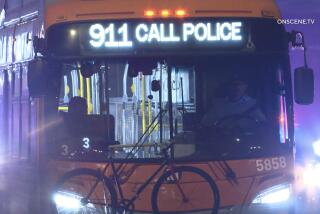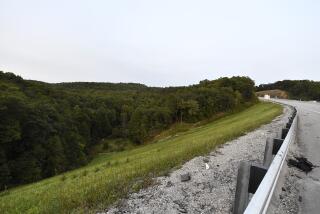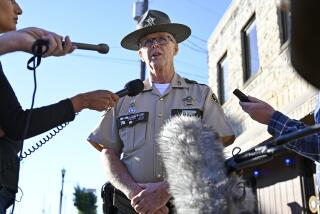Suspect held in Kansas City freeway shootings
KANSAS CITY, Mo. — Since the bullets began to fly on freeways here, Taylor Stevens has stuck to the back roads. Rikki Rohret keeps her eyes on the overpasses. Behind the wheel, Joe Miller tries not to think about being an anonymous gunman’s next victim.
Somebody has been firing at vehicles, a serial triggerman who police warned seemed to be randomly targeting motorists, declaring his own misguided war against his fellow drivers.
Since the shootings began in March, police have linked at least a dozen incidents along the network of freeways that connect this Midwestern city, which sees itself as a genteel cousin of Rome for its fountains, or Paris for its boulevards, not as some hulking U.S. city where an armed man could run amok.
Several people have been struck by gunfire, but so far no one has been killed, authorities say. Law enforcement officials have stepped up patrols, while news reports suggest that the total number of shootings may have surpassed 20.
The rain of bullets has put people on edge. On the freeways, many admit to becoming a bit paranoid when another vehicle pulls up alongside, thinking, “Is the driver looking my way? Does he have a gun?”
“This whole thing scares me,” Miller said as he pumped gas at a QuickStop station. “I don’t carry a gun — freeways are just too emotional a place. But now even I’m thinking of packing something for protection. Though from what, or who, really, I don’t know.”
On Thursday evening, police announced they had made an arrest in the shootings. Kansas City Police Chief Darryl Forte told reporters the suspect is male but declined to release his name or age or say whether he was the only suspect. Forte promised more details Friday.
“We just want everybody to know that we have somebody in custody and that person has not been charged,” he said.
The announcement marked the most significant development yet in a case that has left the city anxious for weeks.
Home to 1.7 million residents, the Kansas City metropolitan area is the eastern gateway to the nation’s prairies, with a fistful of freeways twirling off in all directions. Most of the shootings have taken place along stretches of Interstates 435 and 470 on the Missouri side of the city — either on weekday evenings or daytime Saturday — but a few have been reported in suburban cities on both sides of the Missouri-Kansas state line.
Police have fielded reports of shots fired for days at a time, and then the gunman would suddenly become inactive. In many incidents, the shots were fired from a moving vehicle that then veered onto an exit.
On Monday, a female motorist reported that a man in another car pointed a gun at her minivan as she drove through an area known as the Three Trails Crossing, where many of the incidents have taken place. No shots were fired, and the man sped off, but not before he looked at her and mouthed a word, either “pow” or “boom,” she told police.
On April 10, police were investigating yet another possible incident after someone shot out the rear passenger window of a minivan containing four people stopped at a traffic light in Kansas City. Many reports have come from an area called the Grandview Triangle, where U.S. 71 and Interstates 435 and 470 converge. Some motorists refer to the area as the “Bermuda Triangle” and try to avoid it.
One victim told police he heard two bangs and thought he had run over something on the highway. He had been shot in the calf and later found three bullet holes in a door of his car.
The shootings have become this city’s unwanted urban mystery, attracting state troopers and federal agents. Forte won’t say which shootings investigators have linked or what criteria are being used to tie them together.
Authorities had offered a $10,000 reward for information that leads to an arrest.
“We’ve been blessed so far, but it’s a matter of bullet placement where it goes from minor injury to death,” Forte said recently. “We’re just asking this community, when you have a crime that occurs, step up and help reduce the chance of injury to someone else.”
Serial gunmen have plagued other cities. Over three terrifying weeks in 2002, John Allen Muhammad and a teenage accomplice killed 10 people and injured three others in the Washington area before being arrested in the so-called Beltway sniper attacks. Muhammad was executed in 2009.
In 2004, in Columbus, Ohio, Charles McCoy Jr. was arrested and charged with two dozen shootings and one death. He told police that voices in his head made him shoot at moving vehicles and drop cement bags on them from an overpass. He pleaded guilty to manslaughter and other charges and is serving a 27-year sentence.
Auto clubs assure members that they are more likely to be hit by another car than a bullet. “But any time you’re on the freeway, or in public for that matter, you’re vulnerable,” said Mike Right, spokesman for the Missouri chapter of the Automobile Club of America.
“These are random attacks. What can you do — wear a helmet or stay off freeways entirely? That’s absurd. If you’re a definite target, you can vary your route. Everyone else should just be aware of their surroundings,” Right said.
The attacks have been haunting the city’s psyche. The Kansas City Star recently ran a front-page story with a freeway map marked by bullet holes. The headline read: “Driving Scared.” Other stories have quoted former FBI experts drawing up a possible profile of the gunman. “This is fun behavior for this guy,” one said. “It makes him feel powerful. It makes the rest of his life tolerable.”
More to Read
Sign up for Essential California
The most important California stories and recommendations in your inbox every morning.
You may occasionally receive promotional content from the Los Angeles Times.











